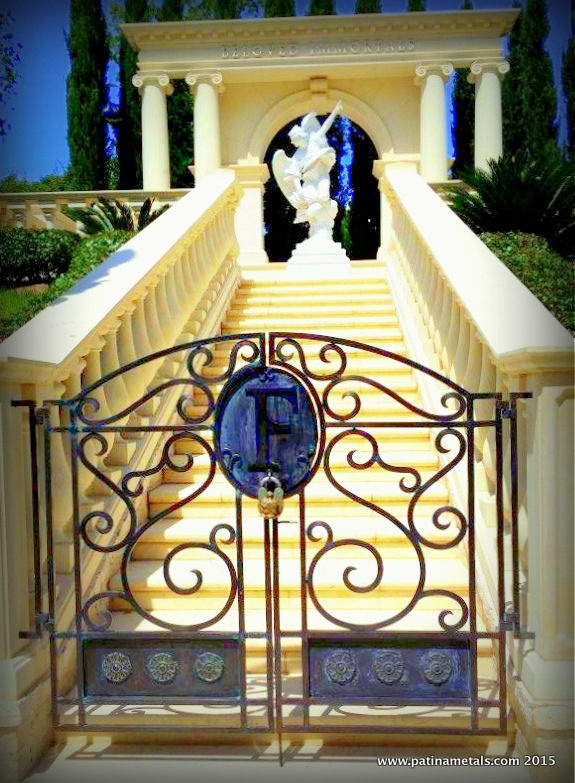Patina Metals was excited about replacing a steel gate with a beautiful creation in brass. Our craftsman and the client worked diligently to create a gate that was as aesthetically fitting to the landscape as it was functional and long lasting. Here is some information on one of the types of metals in which we have expertise and have been working with for over 60 years.

When it comes to your creation, why trust anyone with less experience or less of a commitment to excellence? Brass and Bronze are metal alloys used extensively in everyday objects. While brass is an alloy of copper and zinc, bronze is an alloy consisting mainly of copper, combined most often with tin, but at times also with other metals.
Properties
Brass has higher malleability than zinc or copper. It has a a low melting point (900 centigrade) and flows when melted making it easy to cast in molds. Combinations of iron, aluminum, silicon and manganese make brass wear and tear and corrosion resistant. Susceptible to stress cracking when exposed to ammonia.
History
The first known existence of bronze dates to about 3500 BC and the Sumerians and lends its name to the Bronze age. The discovery of bronze enabled people to create better metal objects than before. Tools, weapons, armor, and various building materials, like decorative tiles, made of bronze were harder and more durable than their stone and copper.
Brass came later dates back to about 500 BC. Zinc is practically never found naturally in its pure state, but people had realized that copper smelted with calamine — a zinc ore — produced a golden-colored tarnish-resistant metal that was useful for all sorts of things due in part to its low melting point and malleability. The zinc itself is not seen but is released from the calamine ore by heating and combines immediately with copper.
Comparison chart
Brass |
Bronze |
|
|---|---|---|
| Composition | Brass is any alloy of copper and zinc. | Bronze is a metal alloy consisting primarily of copper, usually with tin as the main additive, but sometimes with other elements such as phosphorus, manganese, aluminum, or silicon. |
| Properties | Higher malleability than zinc or copper. Low melting point (900 c); flows when melted. Combinations of iron, aluminum, silicon & manganese make brass corrosion resistant. Susceptible to stress cracking when exposed to ammonia. Not as hard as steel. | Hard and brittle. Melts at 950 centigrade but depends on amount of tin present. Bronze resists corrosion (especially seawater corrosion) and metal fatigue more than steel and is also a better conductor of heat and electricity than most steels. |
| Uses | Decorative; Low-friction applications (locks, gears, doorknobs, ammunition, valves); Plumbing/electronics; Musical instruments for acoustic properties; Zippers & uses where it’s important to negate spark(fittings & tools around explosive gas). | Used in boat and ship fittings, propellers and submerged bearings because of resistance to salt water corrosion. Widely used for cast bronze sculpture; Bearings, clips, electrical connectors and springs; For top-quality bells and cymbals. |
| Color | Muted yellow, somewhat similar to gold, but duller. | Reddish brown. |
| History | Brass was first known to exist in about 500 BC. | Bronze dates to about 3500 BC |
Here are some photos of the work in progress.
[easingsliderlite]For those wishing to know a little more about the technical aspects, we use a 30 % argon gas mix, but when welding thicker material we use helium and a higher amperage as was the case for this gate.
We also used a brazing alloy filler to keep temperature down on base metal (brass) to keep porosity of base metal down. You can use a variety of alloys, but we prefer silicone bronze because it helps to keep the temperature and fuming down when reacting with the zinc as brass has some zinc in it and will smoke and fume. It is important that the melting temp of brass is not reached (stay below 900 c) since the metallurgical and mechanical strength of the brass at an atomic level will become compromised, as the solid brass goes to a plasma/ liquid flux and then back to solid again. This is critical from a thermodynamic point of view, especially when you are talking about a hinge point for the gate. Of what use is a hinge for a heavy gate if the underlying material is going to give way at the weld interface in a few decades instead of lasting for centuries? Besides, whatever “Patina” would develop over those decades would have to be removed in order to repair and correct that failure point. This negates the very premise of using such an expensive medium as brass, which is made to last a lifetime, instead of steel.
You can trust Patina Metals for your next “showcase” ornamental gate, fence, or railing.
